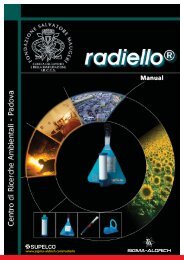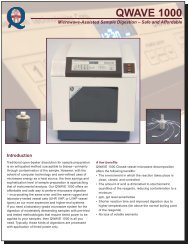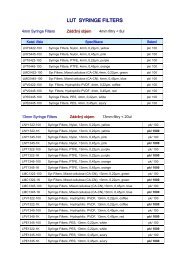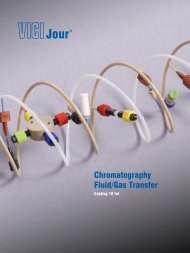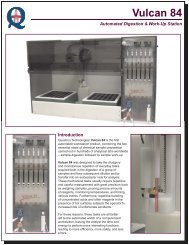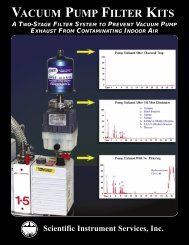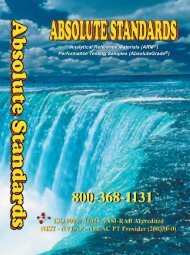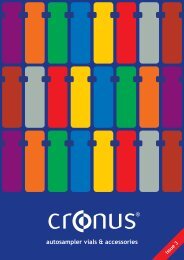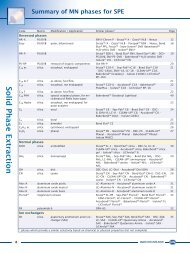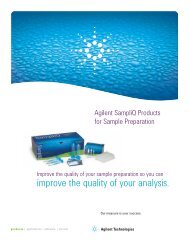You also want an ePaper? Increase the reach of your titles
YUMPU automatically turns print PDFs into web optimized ePapers that Google loves.
HIGH PRESSURE VALVES<br />
Sample Injector Application Notes<br />
Application Note<br />
Application Note<br />
How to Properly Install Sample Loops<br />
Stainless Steel<br />
Stainless steel sample loops are supplied with fittings that are not<br />
swaged onto the tube. It is important that the loop be completely<br />
bottomed in the injector port before the ferrule is swaged onto the<br />
tube. The depth of the tubing holes may vary slightly from port to<br />
port and from valve to valve. A fitting made up in one port may leave<br />
a small cavity in another port. The cavity causes high dispersion<br />
and peak distortion such as fronting, tailing, or broadening. It is<br />
good practice to label loop ends so they will be replaced in the<br />
same, respective ports that were used in swaging the ferrules.<br />
<br />
valve port makes loop installation easier.<br />
A<br />
B<br />
C<br />
Figure 1 Cut-away view<br />
of stainless steel sample<br />
loop installation.<br />
To install the sample loop:<br />
a) Take one end of the loop and place the<br />
nut (1) and ferrule (2) onto the tubing (3)<br />
with the threaded portion of the nut and<br />
tapered portion of the ferrule toward the<br />
end. See Figure A.<br />
b) Insert the tubing into port (4). Confirm<br />
that the tubing is bottomed in the<br />
valve port as shown in Figure A.<br />
c) While firmly pressing down on the<br />
tubing, hand-tighten the nut as tight<br />
as possible.<br />
d) With the Rheodyne ® Wrench (see page<br />
96), designed especially for fittings,<br />
tighten one quarter turn past finger tight.<br />
Remove the loop to confirm the ferrule is<br />
swaged onto the tube.<br />
e) Repeat steps a-d with the other end of<br />
the loop while the swaged end remains<br />
outside the valve port. See Figure B.<br />
f) Reinstall each end of the loop to their<br />
respective ports. See Figure C.<br />
RheFlex ® PEEK Fittings and PEEK Tubing<br />
PEEK loop installation requires steps a-c in the stainless steel section<br />
above. Finger tightening of PEEK fittings is adequate to make a leakfree<br />
connection. The slotted backside of the ferrule (1) is squeezed<br />
down onto the tube (2) by the mating conical surface in the nut (3).<br />
See Figure 2. The nut and ferrule can both be reused many times.<br />
Unlike ordinary fittings, the unique RheFlex PEEK design, specifically<br />
the angles and surface contacts between the ferrule and nut, prevents<br />
the nut from gripping the ferrule and twisting both the ferrule and the<br />
<br />
tubing and lowers the pressure rating of the tubing.<br />
Figure 2 Cut-away<br />
view of PEEK sample<br />
loop installation.<br />
The ferrule can slide and reposition<br />
itself along the tube when the fitting is<br />
reinserted into a port. It is important that<br />
the PEEK tubing is completely bottomed<br />
in the injector port before the fittings are<br />
tightened to avoid leaving an undesired<br />
cavity. Both stainless steel and PEEK<br />
sample loops are listed on pages 96 – 97.<br />
Sample Loop Loading:<br />
Partial-Filling vs. Complete-Filling<br />
Partial-Filling<br />
Use the partial-filling method if you need to conserve sample, or if<br />
you want to vary sample volume frequently.<br />
In partial-filling, the syringe sets the volume injected onto the<br />
column. There is no sample waste, and the volume injected onto the<br />
column is equal to that dispensed from the syringe. Reproducibility<br />
is 1.0% relative standard deviation (RSD). The volume of the sample<br />
loaded is limited to half the sample loop volume. For example, the<br />
most you can load into a 200 µL sample loop is 100 µL. See Figure 1.<br />
This limitation is because fluidic movement in tubes affects<br />
reproducibility. See the “Fluidic Movement in Tubes” Application<br />
Note on page 99.<br />
Complete-Filling<br />
Figure 1 The sample loop can fi ll<br />
up to half the loaded volume in<br />
partial-fi lling method.<br />
Use the complete-filling method if you have plenty of sample, if you<br />
do not vary sample volume, or if you need high reproducibility.<br />
In complete-filling, the loop sets the volume loaded onto the<br />
column. Use excess sample (two to five loop volumes) to replace all<br />
the mobile phase in the loop. See Figure 2. Change the loop to vary<br />
the sample volume. Reproducibility is typically 0.1% RSD for loop<br />
sizes ≥ 5 µL. Accuracy is limited as loop volumes are nominal.<br />
Q: “Which method should I use and which Rheodyne sample<br />
injectors use this method”<br />
A: There are two types of injectors available: dual mode and single<br />
mode. Dual mode injectors allow both partial- and complete-filling<br />
whereas single mode injectors allow only complete-filling. See<br />
Sample Injectors on pages 89 – 91.<br />
If you are collecting experimental data, sample is scarce, and/or you<br />
want to use different sample volumes, a dual mode injector with a<br />
<br />
allow the partial-filling method for easily varying your volumes (up to<br />
<br />
you begin routine analysis, and/or you have an abundance of sample,<br />
either a dual mode or single mode injector is appropriate. Both types<br />
of injectors allow the complete-filling method in which you overfill<br />
the sample loop. Complete-filling maximizes the reproducibility of<br />
your results.<br />
Figure 2 The sample loop is fi lled<br />
in excess in complete-fi lling method.<br />
98<br />
ORDER



